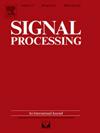Wideband multitarget passive tracking based on belief propagation theory
IF 3.4
2区 工程技术
Q2 ENGINEERING, ELECTRICAL & ELECTRONIC
引用次数: 0
Abstract
In passive acoustic monitoring system, information is typically derived from radiated noise signals of targets distributed across multiple subbands. When targets are close in the node field of view, direct processing of the entire frequency band may lead to premature merging of detection results or masking of weaker targets due to differences in energy distribution among the target bands. This situation can degrade the performance of tracking algorithms because the downstream tracking processing cannot compensate for the loss of upstream measurements. This study proposes a novel wideband multitarget tracking algorithm based on belief propagation to address this challenge. Initially, a merged target model is established to simulate the mechanism of measurement generation from multiple targets. Based on this model, merged targets and each subband measurement form a cyclic association structure. This structure is processed using the loopy belief propagation algorithm to prevent the combinatorial explosion. A mixture of belief and mutual information entropy weight is established for each subband to fuse all posterior probability density functions, considering differences in subband energy distribution. Simulation and lake trial results demonstrate that this algorithm substantially improves the tracking capabilities of passive acoustic monitoring system for wideband targets, underscoring its practical application value.
求助全文
约1分钟内获得全文
求助全文
来源期刊

Signal Processing
工程技术-工程:电子与电气
CiteScore
9.20
自引率
9.10%
发文量
309
审稿时长
41 days
期刊介绍:
Signal Processing incorporates all aspects of the theory and practice of signal processing. It features original research work, tutorial and review articles, and accounts of practical developments. It is intended for a rapid dissemination of knowledge and experience to engineers and scientists working in the research, development or practical application of signal processing.
Subject areas covered by the journal include: Signal Theory; Stochastic Processes; Detection and Estimation; Spectral Analysis; Filtering; Signal Processing Systems; Software Developments; Image Processing; Pattern Recognition; Optical Signal Processing; Digital Signal Processing; Multi-dimensional Signal Processing; Communication Signal Processing; Biomedical Signal Processing; Geophysical and Astrophysical Signal Processing; Earth Resources Signal Processing; Acoustic and Vibration Signal Processing; Data Processing; Remote Sensing; Signal Processing Technology; Radar Signal Processing; Sonar Signal Processing; Industrial Applications; New Applications.
 求助内容:
求助内容: 应助结果提醒方式:
应助结果提醒方式:


